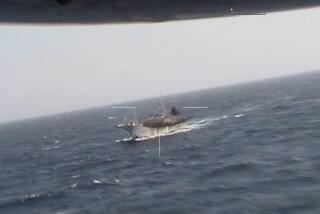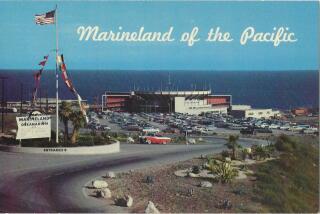Marlin Make a Comeback : Conservation Efforts of Last Decade Result in Greater Numbers of Billfish off Cabo San Lucas
- Share via
CABO SAN LUCAS, Mexico — The monster billfish emerged from the depths with angry eyes, its huge mouth agape and its long, bony snout pointing toward the sky.
Joe Gentile’s jaw dropped.
“I’ve been fishing Cabo for 20 years and I never saw anything like it my whole life,” said the 40-year-old Chatsworth resident, who goes by the nickname “Rocky.” “All I could say is, ‘Oh, my God!’ ”
Nearly 20 feet long and thick as a rhino, it was one of the largest blue marlin ever to surface off Land’s End.
Gentile was looking astern when the broad-shouldered beast popped out of the sea only 20 feet away. It whacked one of the trolling lures aside and inhaled the one at the end of Gentile’s line.
“I almost went over the side of boat,” said Gentile, who was holding the rod at the time. “I had to (loosen) the drag just to get back in the fighting chair.”
Strapped in, using state-of-the-art gear and aided by some fancy boat maneuvering by skipper Bob Hamm, Gentile had the fish in the boat in less than an hour.
Carlos, the deckhand, stuck it with a flying gaff, but the gaff-head failed to disconnect. The fish dove and Carlos, still holding on, went overboard, landing almost on top of the marlin, which could have done him in with one swipe of its bill.
“We were all shouting, ‘Carlos, swim away!’ Gentile recalled of the incident nearly two weeks ago. “I was wearing a white T-shirt and . . . he turned just as white. His eyes were as big as the whole outdoors.”
Carlos was able to climb back aboard the boat. The billfish was then subdued with another gaff, hauled through the transom and “hog-tied” on deck.
Back at the marina, 12 people were needed to drag it up the ramp to the scale, where it measured 17 feet and weighed 993 pounds.
For winning the Bisbee’s Black and Blue marlin tournament, the world’s richest, Gentile and his team netted more than $500,000 in money and prizes.
Still, Gentile said, “I felt very bad about keeping it, we usually release everything we don’t eat. But it was a 1,000-pounder and we were in a tournament. And it ended up feeding a lot of poor people in town, so. . . .”
*
It is sad when such a magnificent creature is taken from its world for the sake of money, but at the same time, were it not for people like Gentile, such creatures might not be thriving as they apparently are these days off Land’s End.
Last winter, there were so many striped marlin you could almost walk on them.
“It was crazy then, there were so many boats fishing for them they were almost crashing into each other,” said Tracy Ehrenberg, 30, who with her husband, Marco, owns the Pisces Fleet.
And the late summer and fall have produced some of the best fishing anywhere for blue and black marlin, with many in the 500-pound class and some, such as Gentile’s, nearing 1,000 pounds.
This, many say, is a direct result of Cabo’s growing conservation movement, born of necessity a decade or so ago. Every year, more marlin fishermen get hooked on catch-and-release.
“Now we’re even releasing blue marlin,” said Marco Ehrenberg, whose Pisces Fleet boasts a release rate of nearly 80%. “Before, it didn’t matter what size blue. A 100-pounder? You killed it, just because it was a blue marlin. Today, they say, ‘Oh I released a 300-pounder, a 400-pounder. Five years ago, that would be on the dock.”
The Billfish Foundation of Fort Lauderdale, Fla., which promotes billfish conservation, has honored Pisces with its group achievement award in four of the last five years.
But Pisces isn’t alone. Other fleets now stress release as well, and many of the hotels award customers certificates for setting their marlin free.
About the only marlin being killed these days, it seems, are in tournaments. But even tournaments, a huge source of revenue, have gotten into the act. Some offer prizes for most releases as well as for biggest fish.
In the Bisbee’s event, only fish weighing more than 300 pounds were eligible for weigh-in, and only 19 met that requirement. About 150 smaller marlin were released. Gentile said he would have gladly released his near-grander, had there been a way to weigh the fish at sea.
But then, who would have believed him, what with the money at stake?
“If people were honest, we could have the greatest tournaments in the world--all release tournaments--but they’re not,” said Bob Smith, a 20-year Cabo resident whose wife, Minerva, is the local International Game Fish Assn. representative and runs a tackle store and the sportfisher, Minerva III.
Perhaps not. But most of the thousands who compete in tournaments here are also avid year-round anglers who, like many who come to Cabo each year, have long since quit slaughtering their billfish for the mere sake of having their pictures taken with them.
“The last time I killed a marlin--and, believe me, I do a lot of fishing--was probably five years ago,” said Tom Lowey, 73, a retired San Diego-area car dealer who has been fishing in Cabo for 30 years.
*
Thirty years ago Cabo San Lucas had a couple of hotels and a cleared strip of dirt for an airport. The city was born because of the abundance of marlin off its coast and now, with a resident population of about 30,000, still relies on the swift and powerful billfish for its survival.
“If there weren’t any marlin, there wouldn’t be any of that,” said Dave Kaminski, 57, pointing from the deck of a cruiser to a sprawling city that now boasts dozens of hilltop mansions and a waterfront cluttered with condos and five-star resorts.
Kaminski and his family, from Indiana, discovered Cabo San Lucas 10 years ago and have been coming here twice a year since. “We don’t fish tournaments, and we don’t keep marlin,” said Chris Kaminski, 31.
A refreshing attitude, considering that the marlin resource was dwindling rapidly in the 1980s, in large part because of pressure by the foreign long-line fishing fleet, which was expelled a few years ago, but also because of the growing number of tourists.
Today an average of about 300 boats, with two to six anglers aboard, leave the harbor every morning to try their luck on the high seas. Some still return with dead marlin, and occasionally a 70- or 80-pounder is hung from the waterfront scale.
But more often it is only the marlin flags fluttering in the wind that indicate a boat’s success.
“We will not advertise with a dead fish on our boat,” Tracy Ehrenberg said. “People come in and when we sign them up, we start by asking, ‘What do you want to do with your marlin if you’re lucky enough to catch one?’ And nearly everybody now says, ‘We want to release them.’ ”
Thanks to a law passed a few years ago, at the behest of hotel owners and the local sportfishing association, those who insist on killing their marlin are allowed one a day. The sportfishing association is pushing for an even stricter limit.
“The law says you can kill one, so six guys with licenses go out on one boat--they can kill six marlin,” said Marco Ehrenberg, president of the association. “We’re trying to get the law changed to one marlin per boat and as many releases as you want.”
Given that these waters are prolific with a variety of challenging and tasty game fish, notably tuna, dorado and wahoo, few are likely to complain.
The hardest to convince that killing marlin is not in anyone’s best interest in the long run are some of the local cruiser and panga captains and crews--mostly independent operators or those from the smaller fleets--who have long relied on marlin as a means of advertising but also as food.
“The only problem we really have here now is with our own people who won’t release the fish,” Smith said. “But you’ve got to remember, too, that for many, many years, that was their diet here. That was the only thing they had to eat.
“There was no electricity, there was no refrigeration, so they would cut the marlin up, take it home, salt it and hang it over the clothesline. You didn’t see any clothes on the clothesline; it was all marlin. So it’s going to take them awhile to get over that.”
Perhaps, but judging from the number of flags flying in the hot afternoon sun these days, it seems they’re on the right track.
More to Read
Sign up for Essential California
The most important California stories and recommendations in your inbox every morning.
You may occasionally receive promotional content from the Los Angeles Times.










